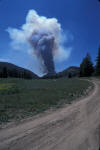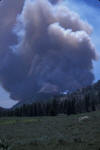Hinman Fire
Friday, July 12 was a beautiful but hot and windy day. I was hiking Wyoming Trail 1101, working my way northward from Seedhouse Road while measuring the trail and taking pictures for this website.
We were in the midst of the driest weather in Colorado history and the Hayman Fire had just broken all records for Colorado Wildfires. The fire danger was rated extreme and burn restrictions remained in effect state wide. I was aware of the possible danger of encountering such a fire, but in retrospect, having no personal experience with wildfires I didn't full comprehend the danger.
Upon reaching my planned turnaround point, I crossed the west edge of Diamond Park on Wyoming Trail, about five and a half miles from my truck. Looking toward the west, at first I couldn't believe my eyes. A black plume of smoke climbed into the sky from the forest about a mile and a half away. I actually studied the scene for a few seconds to make sure it was real. It didn't take long to realize that this was a wild fire that was just beginning, and I quickly snapped a picture at 1:20 pm.
 You can click on the thumbnail of the picture taken 1:20 pm to view it full size. You can click on the thumbnail of the picture taken 1:20 pm to view it full size.
It took me 20 minutes to place a 911call to report the fire before I got to the Diamond Park Trailhead to get a better look at the developing conflagration. The wind was to my back so I didn't feel in any immediate danger of being overrun by the fire. By the time I reached the turnoff to the Diamond Park Trailhead off Diamond Park Road it was about 1:45 pm and the fire could be seen clearly for the first time.
 Click on this thumbnail to view the picture of the fire taken near Diamond Park Trailhead at 1:45 pm. Click on this thumbnail to view the picture of the fire taken near Diamond Park Trailhead at 1:45 pm.
The speed at which the fire grew was stunning. In about 20 minutes it had grown in size by a factor of about 100X. Having no experience with wildfire, for some reason I expected a fire fightning airplane to suddenly appear overhead, then gracefully swoop down and douse the fire before it got out of control. It was unnerving to watch the fire grow out of control so quickly. The forest service later said the blaze initially grew at a rate of about 100 acres an hour. Watching a fire like that in action puts you in your place. You realize that there are times when you are completely powerless to change some situations: fire is one of the elemental forces of nature that supersedes our power.
Columns of flames were soon shooting into the air above the blaze, dwarfing the trees they had enveloped. I switched to a telephoto lens to get close up shots of the conflagration as it continued to spread over the hilltop where it started.
 Click on the thumbnail for a closer view of the fire, taken between 1:45 and 2:00 pm. Click on the thumbnail for a closer view of the fire, taken between 1:45 and 2:00 pm.
 Click on this thumbnail to see how the smoke plume continues to grow, taken at about 2:00 pm. Click on this thumbnail to see how the smoke plume continues to grow, taken at about 2:00 pm.
 Click on the thumbnail to see a closer view of plumes of flames rising from the fire, taken after 2:00 pm. Click on the thumbnail to see a closer view of plumes of flames rising from the fire, taken after 2:00 pm.
 Click on the thumbnail to see the smoke plume rising from the fire, taken about 2:25 pm as I was leaving. Click on the thumbnail to see the smoke plume rising from the fire, taken about 2:25 pm as I was leaving.
After watching the fire grow for about 40 minutes, I started back for my truck. The sun was blotted from the sky by the smoke plume that continued to grow by the time I got back to Seedhouse Road. By that night, ashes rained down from the sky at my campsite about six miles south of the fire.
The Forest Service would later say that this fire was caused by lightning strikes from thunderstorms that had moved through the area days earlier. The fire had apparently smoldered for two or three days before the hot temperatures and brisk winds were right to bring it alive. It took a couple weeks before the blaze was brought under control, and the proximity of the homes and businesses along Seedhouse Road made it the top firefighting priority in the state during that time. The fire was brought under control the first time with no fire fighters or others being injured in the process.
It turned out that the Hinman Fire would live to burn another day, in a much more fierce incarnation. The fire had been contained and all trails in the area were re-opened a couple weeks after it broke out. Rains came that helped to contain the fire, but another long hot dry spell began that continued to dry the forest. The Hinman Fire waited. Firefighter crews continued to work the containment line around the fire extinguishing any flare-ups.
On Friday, August 16, 50 mile-per-hour winds blew through the area and a single ember landed outside the containment lines igniting the dry debris on the forest floor, or duff. In 30 minutes the fire sparked by a single ember had grown to 500 acres. The blaze quickly jumped the North Fork of the Elk River and soon reached the thousands of tinder dry trees from the Routt Divide Blowdown of 1997. Within 24 hours 9,000 acres of forest and blown down timber would be consumed by the fire. By the next day the fire would be 16,000 acres in size.
Firefighters were pulled off the blaze the day it re-ignited for their safety. Veteran firefighters from the area described the fire behavior as "awesome". No one had ever seen fire behavior like this before in the Routt National Forest. It turned out that the timber left standing in the forest was particularly vulnerable to a fire due to the spruce beetle epidemic that followed the Routt Divide Blowdown. Anywhere from 30% to 60% of the spruce in the forest had been killed by the beetle. In some places 90% of the spruce were dead, but they remained green and standing. They appeared to be alive but were instead dead and tinder dry. This situation coupled with the worse drought in Colorado history set the stage for fire behavior never seen in modern times in the Routt National Forest.
I ventured within sight of the fire on Sunday, August 18, and snapped a few pictures.
 Click on the thumbnail to see the trail creek valley after the Hinman Fire re-ignited, picture taken 8/18/02 Click on the thumbnail to see the trail creek valley after the Hinman Fire re-ignited, picture taken 8/18/02
 Click on the thumbnail to see Big Agnes Mountain while the Hinman Fire was active, picture taken 8/18/02 Click on the thumbnail to see Big Agnes Mountain while the Hinman Fire was active, picture taken 8/18/02
Harnessing and mastering fire has allowed the industrial revolution and all of the things we take for granted. We burn controlled fires to generate electricity, to propel our cars, planes and trains. It's so easy to forget that fire existed before we learned to harness and control it. We forget that fire is in fact one of the elemental forces that shaped us before we learned to harness and control it.
By experiencing this fire first hand, I was reminded that there are still wild fires. Even if we don't smoke while pumping gas, don't play with matches, fires beyond our control still exist. These fires are very different that the ones that burn in our furnaces.
The best we can hope is to reach an understanding with a wildfire, to live with the fire. Many believe that the devastating wildfires we have experienced in recent years are due in part to our fanatical efforts to fight them during the last century, desperately holding on to the illusion that we are in control of fire. If so, we have only created a worse situation that we are forced to deal with now. We have simply held the fires at bay for a short time and they have returned with a vengeance.
The experience of seeing this fire, and living around it over the next couple months, made me realize that fires can teach us some of the same lessons that wilderness does. Sometimes by trying to control our environment we do harm instead of good, and we do so at our own peril. Wilderness preservation is in part an acknowledgement of that fact.
Wilderness provides us with a baseline, a point of reference where we can return to see the beauty and brutal perfection of natural processes, a place where the elemental forces of nature; earth, wind, water, and fire reign supreme. The earth heaves and buckles over millions of years thrusting mountains into the skies. The winds bring water, sometimes in the form of giant rivers of ice, carving and shaping the mountains, slowly eroding them away. Trees grow by fixing carbon from the wind, while drawing water and nutrients from the earth. Occasionally, the winds flatten massive stands of timber like so many matchsticks. The winds then bring lightning sparking fires that reduce the fallen timber to earth and wind once again. And the cycle continues, right before our eyes.
These forces have combined to form the beautiful areas that we love, and while we may not understand their ways, its hard for us mere mortals to improve on the results. Wilderness shows us that there is much to be gained by accepting and enjoying the world as it is, shaped by forces beyond our control. Likewise, fire teaches us that sometimes all we need to understand about nature's way, is to stay out of it.
|